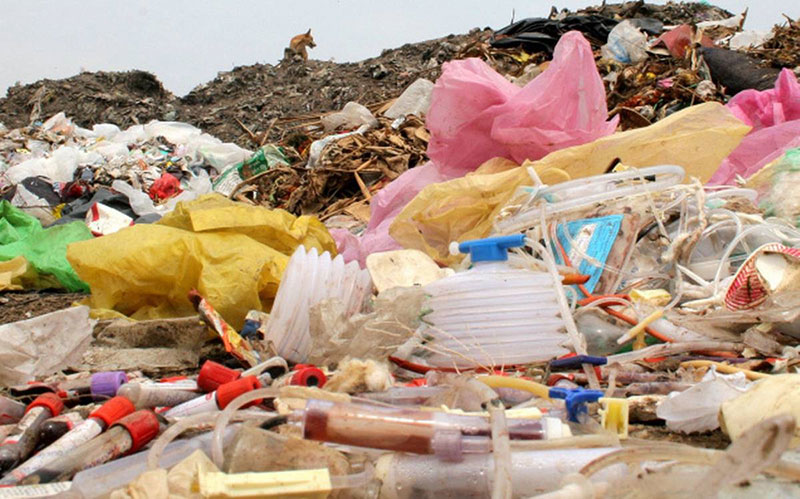What is health-care waste? What are the guidelines for health-care waste classification in Vietnam? - Tran Nhu (Ninh Thuan, Vietnam)

Guidelines for health-care waste classification in Vietnam (Internet image)
1. What is health-care waste?
According to Clause 1, Article 3 of Vietnam's Circular 20/2021/TT-BYT, health-care waste refers to waste that is generated from activities of healthcare facilities, including: hazardous health-care waste, ordinary solid waste, non-hazardous emissions and liquid waste and healthcare wastewater.
2. Guidelines for health-care waste classification in Vietnam
Article 4 of Circular 20/2021/TT-BYT stipulates health-care waste classification in Vietnam as follows:
- Infectious waste includes:
+ Infectious sharps waste: needles, syringes with needles, intravenous line (IV) cannulas, puncture needles, acupuncture needles; scalpel blades, surgical nails, saws; used and disposed syringes, glass sharps, sharp objects, that is contaminated with or contains the human blood or pathogenic microorganisms;
+ Infectious non-sharps waste: cottons, bandages, gauzes, gloves, and other non-sharp wastes that is not contaminated with or contains blood or pathogenic microorganisms; discarded inactivated vaccine or attenuated vaccine bottles; infectious liquid waste (includes drainage fluid after surgery or medical procedures and fluid waste that contains human blood or pathogenic microorganisms);
+ Highly infectious waste: specimens, tools that contain specimens, wastes that contain discarded specimens from BSL-2 laboratories equivalent (biosafety level 2) or above; waste from isolation rooms, isolation wards, sampling areas for patients who have dangerous infectious diseases of group A and group B;
+ Surgery waste: tissues, discarded human parts, and experimental animal carcasses;
- Non-infectious hazardous waste includes:
+ Discarded chemicals with ingredients and properties exceeding the hazardous waste threshold or with hazard warnings on their labels;
+ Discarded pharmaceutical products falling under the cytotoxicity category or with hazard warnings on their labels;
+ Medicine or chemical bottles and jars, other tools that contain medicine or chemical in the cytotoxicity category; or bottles that have hazard warnings on their labels;
+ Discarded used broken medical equipment which contains mercury, Cadmium (Cd); discarded batteries; discarded lead-coated materials used in radiation shielding;
+ X-Ray film developer solutions, wastewater from testing and analysis equipment, and discarded fluids with hazardous elements exceeding the hazardous waste threshold;
+ Other health-care wastes that have ingredients and properties exceeding the hazardous waste threshold or have hazard warnings on their labels;
- Ordinary solid waste includes:
+ Solid domestic waste from daily activities of medical staff, patients, families of patients, students, guests, and outdoor wastes within healthcare facilities (excluding domestic waste generated from isolation wards for patients who have dangerous infectious diseases);
+ Discarded chemicals without ingredients and properties exceeding the hazardous waste threshold;
+ Medicine or chemical bottles and jars, other tools that contain medicine or chemicals that do not fall under the cytotoxicity category; or bottles and jars that do not have hazard warnings on their labels;
+ Discarded bottles of vaccines other than inactivated vaccines or attenuated vaccines;
+ Non-infectious non-sharps that are wastes without ingredients and properties exceeding the hazardous waste threshold;
+ Treated infectious wastes that meet the national technical regulation on environment;
+ Discarded sludge without ingredients and properties exceeding the hazardous waste threshold from the wastewater treatment system; ashes or slag without ingredients or properties exceeding the hazardous waste threshold from solid health-care waste incinerators;
+ Other ordinary solid wastes;
+ The list of recyclable ordinary solid wastes allowed to be collected is prescribed in Appendix 1 promulgated with this Circular.
- Emission includes emissions from laboratories for pathogens of dangerous and airborne infectious diseases; emissions from BSL-3 laboratories or above.
- Non-hazardous liquid waste includes discarded liquid medicines and chemicals that do not fall under cytotoxicity category, do not have hazard warnings from manufacturers, do not contain ingredients or properties exceeding hazardous waste threshold, and do not contain pathogenic microorganisms.
- Health-care wastewater includes wastewater from professional activities in healthcare facilities. Health-care wastewater management shall apply to domestic wastewater if they use the same wastewater collecting system.
Thanh Rin
 Article table of contents
Article table of contents





.Medium.png)
.Medium.png)
.Medium.png)
.Medium.png)
